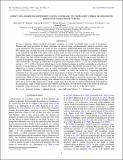| dc.contributor.author | Webber, M. W. | |
| dc.contributor.author | Lewis, N. K. | |
| dc.contributor.author | Marley, M. | |
| dc.contributor.author | Morley, C. | |
| dc.contributor.author | Fortney, J. J. | |
| dc.contributor.author | Cahoy, K. | |
| dc.date.accessioned | 2017-08-01T20:07:58Z | |
| dc.date.available | 2017-08-01T20:07:58Z | |
| dc.date.issued | 2015-05-10 | |
| dc.identifier.issn | 0004637X | |
| dc.identifier.uri | http://hdl.handle.net/1721.1/110902 | |
| dc.description.abstract | We use a planetary albedo model to investigate variations in visible wavelength phase curves of exoplanets. Thermal and cloud properties for these exoplanets are derived using one-dimensional radiative-convective and cloud simulations. The presence of clouds on these exoplanets significantly alters their planetary albedo spectra. We confirm that non-uniform cloud coverage on the dayside of tidally locked exoplanets will manifest as changes to the magnitude and shift of the phase curve. In this work, we first investigate a test case of our model using a Jupiter-like planet, at temperatures consistent to 2.0 AU insolation from a solar type star, to consider the effect of H2O clouds. We then extend our application of the model to the exoplanet Kepler-7b and consider the effect of varying cloud species, sedimentation efficiency, particle size, and cloud altitude. We show that, depending on the observational filter, the largest possible shift of the phase curve maximum will be similar to 2 degrees-10 degrees for a Jupiter-like planet, and up to similar to 30 degrees (similar to 0.08 in fractional orbital phase) for hot-Jupiter exoplanets at visible wavelengths as a function of dayside cloud distribution with a uniformly averaged thermal profile. The models presented in this work can be adapted for a variety of planetary cases at visible wavelengths to include variations in planet-star separation, gravity, metallicity, and source-observer geometry. Finally, we tailor our model for comparison with, and confirmation of, the recent optical phase-curve observations of Kepler-7b with the Kepler space telescope. The average planetary albedo can vary between 0.1 and 0.6 for the 1300 cloud scenarios that were compared to the observations. Many of these cases cannot produce a high enough albedo to match the observations. We observe that smaller particle size and increasing cloud altitude have a strong effect on increasing albedo. In particular, we show that a set of models where Kepler-7b has roughly half of its dayside covered in small-particle clouds high in the atmosphere, made of bright minerals like MgSiO3 and Mg2SiO4, provide the best fits to the observed offset and magnitude of the phase-curve, whereas Fe clouds are found to be too dark to fit the observations. | en_US |
| dc.language.iso | en_US | en_US |
| dc.publisher | IOP Publishing | en_US |
| dc.subject | planetary systems | en_US |
| dc.subject | radiative transfer | en_US |
| dc.subject | Kepler-7 | en_US |
| dc.subject | photometric | en_US |
| dc.title | Effect of Longitude-Dependent Cloud Coverage on Exoplanet Visible Wavelength Reflected-Light Phase Curves | en_US |
| dc.type | Article | en_US |
| dc.identifier.citation | Webber, M., Lewis, N., Marley, M., Morley, C., Fortney, J., & Cahoy, K. (n.d). EFFECT OF LONGITUDE-DEPENDENT CLOUD COVERAGE ON EXOPLANET VISIBLE WAVELENGTH REFLECTED-LIGHT PHASE CURVES. Astrophysical Journal, 804(2) | en_US |
| dc.contributor.department | Space Telecommunications Astronomy and Radiation (STAR) Lab | |
| dc.contributor.department | Massachusetts Institute of Technology. Department of Aeronautics and Astronautics | |
